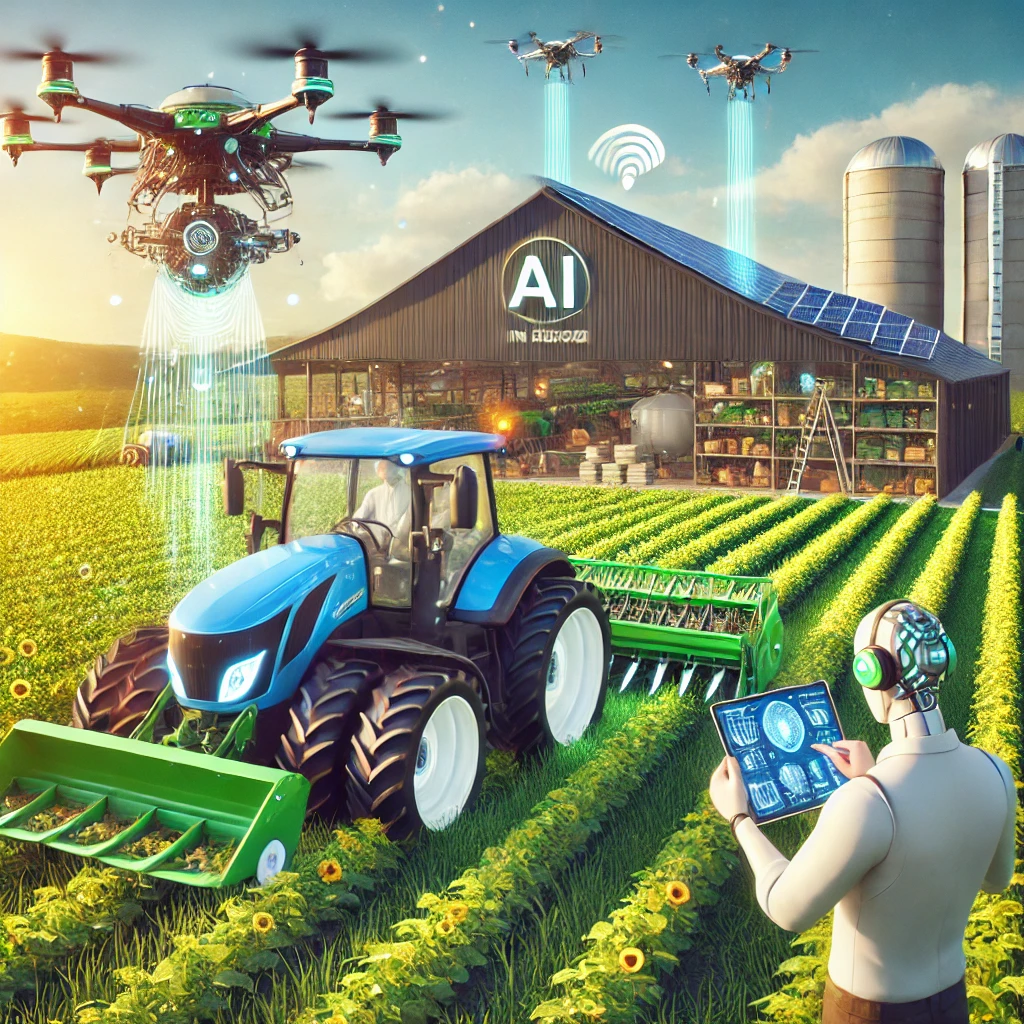AI in Agriculture: Innovative Applications Changing Farming
As the sun rises over the lush fields of Pat, a small village in Madhya Pradesh, Shakuntla Devi steps out of her modest home—not with a hoe or a sickle, but with a sleek tablet in hand. The year is 2025, and the face of Indian agriculture has transformed dramatically. “Namaste, Shakuntla Ji,” greets Kisan Mitra, the artificially intelligent assistant on her device. “Today’s weather forecast suggests a 30% chance of light showers. Shall we adjust the irrigation schedule?” Shakuntla nods, her eyes twinkling with a mix of wonder and pride. Just a decade ago, such technology seemed like a distant dream for small-scale farmers like her. Now, it is an integral part of her daily routine.
As she walks through her fields, swarms of nano drones buzz overhead, their multispectral cameras scanning every inch of the crop. The data they collect feeds into the Kisan Mitra neural network, providing real-time insights on crop health, pest infestation, and nutrient deficiencies. “Alert! Alert!” Kisan Mitra suddenly announces. “Signs of stem borer detected in the northeastern quadrant of your paddy field. Recommended action: targeted application of neem-based biopesticide.” Shakuntla taps her approval, and a sleek, solar-powered robot emerges from its charging station. It glides silently through the field, its precision sprayers delivering the exact amount of biopesticide needed—leaving the rest of the crop untouched.
Shakuntla remembers her grandfather commenting, “You won’t believe it, but we used to spray entire fields with chemicals, hoping to kill pests. Now, look at us—talking to machines, watching robots help our crops. It’s like magic!” She smiles, remembering her own initial skepticism. But the results were undeniable. Crop yield had doubled, water usage had halved, and for the first time in generations, young people were returning to agriculture, armed with tablets and degrees in agritech. As the day progresses, Kisan Mitra keeps Shakuntla updated on various aspects of her farm. “Your tomatoes will be ready for harvest in three days. Current market price trends suggest waiting an additional 48 hours for optimum returns.” By sunset, as Shakuntla reviews the day’s analytics, she feels a sense of empowerment that her ancestors could never have imagined.
The AI revolution has not just transformed agriculture—it has revolutionized rural life itself. As she prepares for bed, Shakuntla glances at the “Wall of Fame” in her living room. There, alongside photos of her grandparents working under the sun, hangs her own portrait: “Shakuntla Devi, AgTech Pioneer of Pat.” “Good night, Kisan Mitra,” she says, setting her tablet aside. “Good night, Shakuntla Ji,” the AI assistant responds. “Rest well. Tomorrow, we shall cultivate the future.” Under the canopy of stars, the fields of Pat hum softly with the promise of a new dawn, where tradition and technology thrive in perfect harmony—nurturing not just crops, but dreams.
We strongly recommend that you check out our guide on how to take advantage of AI in today’s passive income economy.
Table of Contents
Addressing Key Challenges Faced by Farmers with AI
Dr. Srikant Rupavatam, Head of the Innovation Hub and Senior Scientist at the International Crop Research Institute for the Semi-Tropics, has spent years researching AI’s role in agriculture. “The problems faced by farmers are well known,” he explains. “One is getting proper seeds at the right time, followed by securing fertilizers and pesticides when needed. Then there are advisories related to climate and crop protection, and the biggest challenge of all—harvesting and securing good post-harvest prices.” These problems are not just unique to India but are faced by farmers across the developing world.
“AI has now begun to play a significant role in improving crop yields,” he continues. “Pest and disease infestations contribute to nearly 30–40% of crop losses globally. AI-driven tools and applications, powered by machine learning, help diagnose plant diseases and provide precise recommendations. The biggest advantage of AI is its ability to provide targeted advisory services to individual farmers in real time. When farmers address problems at the right time, they can take control measures, reducing overall crop losses.”
A notable example is the “Plantic App,” which is freely available to farmers in India and supports 18 global and Indian languages. “A farmer simply takes a photo of their damaged plant using their smartphone. The AI-powered app then detects the issue and provides recommendations based on available data. This reduces the cost of inputs, eliminating the need to buy unnecessary or spurious chemicals,” Dr. Srikant adds.
AI’s Impact on Irrigation Systems and Environmental Benefits
“Water is one of our most precious resources, and AI is helping us optimize its usage,” Dr. Srikant notes. “One of the biggest challenges is the efficient distribution of water. AI models analyze soil moisture levels and predict crop water requirements, enabling irrigation at the right time. This process of precision farming ensures that water use efficiency improves, reducing waste and conserving collective resources.”
AI-powered smart irrigation systems now monitor water distribution in real-time, automating the operation of pumps and irrigation channels. “Instead of manually switching pumps on and off, AI can determine exactly when and how much water is needed based on soil and crop data. This is revolutionary for semi-arid regions where water scarcity is a constant challenge.”
Beyond water conservation, AI also has significant environmental benefits. “By reducing unnecessary irrigation, we not only save water but also prevent overuse of fertilizers and pesticides that could leach into groundwater. This sustainable approach to farming benefits both farmers and the environment.”
AI in Weather Forecasting and Climate Resilience
“Weather forecasting is critical in agriculture,” Dr. Srikant emphasizes. “Farmers rely heavily on timely weather information to make sowing, irrigation, and harvesting decisions. In regions prone to droughts or unpredictable rain patterns, poor timing can lead to massive financial losses.”
Using historical weather data spanning 20–30 years, AI models can predict the best sowing windows for different crops. “For example, groundnut farming is particularly sensitive to dry spells. If a dry spell occurs after germination, farmers can lose their entire seed investment. AI-powered advisory systems now warn farmers in advance, helping them choose optimal sowing periods with a higher probability of rainfall. This level of predictive analytics is game-changing for small and large-scale farmers alike.”
AI-Driven Drone Surveillance and Precision Spraying
“Drones are becoming an essential tool for precision agriculture,” says Dr. Srikant. “Traditionally, farmers had to spray pesticides across entire fields, leading to high costs and excessive chemical use. Today, AI-powered drones equipped with multispectral sensors can identify specific areas affected by pests or diseases.”
By targeting only infected areas, farmers drastically reduce pesticide use, lowering costs while maintaining crop health. “This has a direct impact on reducing environmental pollution and ensuring safer food production. The biggest challenge in rural farming is labor availability. AI-enabled drones and autonomous vehicles help bridge this gap by performing surveillance, monitoring crop health, and automating labor-intensive tasks. It’s like bringing sci-fi technology into rural villages!”
AI in Yield Monitoring, Income Optimization, and Supply Chain Management
“AI is also transforming how farmers track yields and manage supply chains,” Dr. Srikant explains. “AI models analyze historical crop data, real-time growth patterns, and market prices to help farmers optimize their profits.”
For example, AI can recommend the best time to harvest based on projected market fluctuations. “If market trends suggest that waiting a few days will yield higher prices, AI alerts farmers accordingly. This helps small farmers make informed financial decisions and maximize their earnings.”
AI-powered logistics platforms now connect farmers directly to buyers, eliminating middlemen who often exploit them. “With AI-driven supply chain systems, farmers get fair prices, reduce post-harvest losses, and ensure a steady supply of produce to markets. This is one of the biggest advancements AI has brought to the agriculture sector.”
Conclusion
AI in agriculture is not just about futuristic technology—it’s about empowering farmers with better tools, data, and decision-making capabilities. From precision farming and smart irrigation to AI-driven market analytics and supply chain management, artificial intelligence is reshaping the future of farming. With AI, farmers like Shakuntla Devi are not just growing crops—they’re cultivating a smarter, more sustainable future for generations to come.

We strongly recommend that you check out our guide on how to take advantage of AI in today’s passive income economy.




